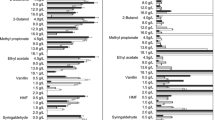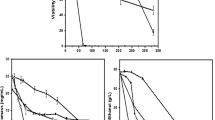Abstract
A high-throughput screening experiment to establish the individual and mixture effects of various common inhibitors found in lignocellulosic hydrolysates on the growth kinetics and ethanol production of Saccharomyces cerevisiae was carried out. Fermentations were performed utilizing 96-well microtiter plates to allow for carrying out fermentations in parallel, around which a central composite design of experiments was used to select inhibitor concentrations in each well. The individual and interaction effects of six common inhibitors were quantified using response surface fits of the growth rate, as determined by optical absorbance measurements and final cell density. For growth rate, 4-hydroxy-methylbenzaldehyde (phenol aldehyde) was found to be the strongest inhibitor of growth rate over the concentration range studied, while m-cresol (phenolic) had the least effect on growth rate and the largest inhibitory effect on final cell density. Both positive and negative interactions between inhibitors were found to affect both growth rate and maximum cell density. For example, both furfural and guaiacol when combined with m-cresol were found to have a positive effect on cell growth (less inhibitory), while guaiacol and m-cresol had a negative interaction with 4-hydroxy-methylbenzaldehyde. At all conditions studied, S. cerevisiae produced identical or higher ethanol yields compared to the inhibitor-free control fermentation which was attributed to the effects of physiological stress cause by the some inhibitors. These results quantify both the interactions of various inhibitors as well as their individual effects in a rapid and easy-to-perform experiment which can be easily expanded to include further inhibitors. Such a design can also be used for rapid and efficient screening of different pretreatments and feedstocks in the emerging field of lignocellulosic biofuels.



Similar content being viewed by others
References
Huang R, Su R, Qi W, He Z (2011) Bioconversion of lignocellulose into bioethanol: process intensification and mechanism research. BioEnergy Res 4:225–245. doi:10.1007/s12155-011-9125-7
Kudakasseril Kurian J, Raveendran Nair G, Hussain A, Vijaya Raghavan GS (2013) Feedstocks, logistics and pre-treatment processes for sustainable lignocellulosic biorefineries: a comprehensive review. Renew Sustain Energy Rev 25:205–219. doi:10.1016/j.rser.2013.04.019
Yu Z, Zhang H (2003) Pretreatments of cellulose pyrolysate for ethanol production by Saccharomyces cerevisiae, Pichia sp. YZ-1 and Zymomonas mobilis. Biomass Bioenergy 24:257–262. doi:10.1016/S0961-9534(02)00147-2
Garcia-Perez M, Wang S, Shen J et al (2008) Effects of temperature on the formation of lignin-derived oligomers during the fast pyrolysis of mallee woody biomass. Energy Fuel 22:2022–2032.
Hendriks TWM, Zeeman G (2009) Pretreatments to enhance the digestibility of lignocellulosic biomass. Bioresour Technol 100:10–18. doi:10.1016/j.biortech.2008.05.027
Chandel AK, Silva SS, Singh OV (2012) Detoxification of lignocellulose hydrolysates: biochemical and metabolic engineering toward white biotechnology. BioEnergy Res 6:388–401. doi:10.1007/s12155-012-9241-z
Westman JO, Taherzadeh MJ, Franzén CJ (2012) Inhibitor tolerance and flocculation of a yeast strain suitable for second generation bioethanol production. Electron J Biotechnol. doi:10.2225/vol15-issue3-fulltext-8
Schwab K, Wood JA, Rehmann L (2013) Pyrolysis by-products as feedstocks for fermentative bio-fuel production: an evaluation of inhibitory compounds via a synthetic aqueous phase. Ind Eng Chem Res 52:18234–18240. doi:10.1021/ie403354k
Franden MA, Pienkos PT, Zhang M (2009) Development of a high-throughput method to evaluate the impact of inhibitory compounds from lignocellulosic hydrolysates on the growth of Zymomonas mobilis. J Biotechnol 144:259–267. doi:10.1016/j.jbiotec.2009.08.006
Huang H, Guo X, Li D et al (2011) Identification of crucial yeast inhibitors in bio-ethanol and improvement of fermentation at high pH and high total solids. Bioresour Technol 102:7486–7493. doi:10.1016/j.biortech.2011.05.008
Palmqvist E, Grage H, Meinander NQ, Hahn-Hägerdal B (1999) Main and interaction effects of acetic acid, furfural, and p-hydroxybenzoic acid on growth and ethanol productivity of yeasts. Biotechnol Bioeng 63:46–55
Jørgensen H (2009) Effect of nutrients on fermentation of pretreated wheat straw at very high dry matter content by Saccharomyces cerevisiae. Appl Biochem Biotechnol 153:44–57. doi:10.1007/s12010-008-8456-0
Mei X, Liu R, Shen F, Wu H (2009) Optimization of fermentation conditions for the production of ethanol from stalk juice of sweet sorghum by immobilized yeast using response surface methodology. Energy Fuel 23:487–491. doi:10.1021/ef800429u
Franden MA, Pilath HM, Mohagheghi A et al (2013) Inhibition of growth of Zymomonas mobilis by model compounds found in lignocellulosic hydrolysates. Biotechnol Biofuels 6:99. doi:10.1186/1754-6834-6-99
Palmqvist E, Hahn-Hägerdal B (2000) Fermentation of lignocellulosic hydrolysates. II: inhibitors and mechanisms of inhibition. Bioresour Technol 74:25–33. doi:10.1016/S0960-8524(99)00161-3
Klinke HB, Thomsen AB, Ahring BK (2004) Inhibition of ethanol-producing yeast and bacteria by degradation products produced during pre-treatment of biomass. Appl Microbiol Biotechnol 66:10–26. doi:10.1007/s00253-004-1642-2
Ding M-Z, Wang X, Yang Y, Yuan Y-J (2011) Metabolomic study of interactive effects of phenol, furfural, and acetic acid on Saccharomyces cerevisiae. OMICS 15:647–653. doi:10.1089/omi.2011.0003
Larsson S, Quintana-Sáinz A, Reimann A et al (2000) Influence of lignocellulose-derived aromatic compounds on oxygen-limited growth and ethanolic fermentation by Saccharomyces cerevisiae. Appl Biochem Biotechnol 84–86:617–632
Baranyi J, Roberts TAT (1994) A dynamic approach to predicting bacterial growth in food. Int J Food Microbiol 23:277–294. doi:10.1016/0168-1605(94)90157-0
Oki S, Omori T, Suzuki N (1964) Some applications of the regular solution theory to solvent extraction—I. J Inorg Nucl Chem 26:2255–2264
Levin M, Redelius P (2008) Determination of three-dimensional solubility parameters and solubility spheres for naphthenic mineral oils. Energy Fuel 22:3395–3401
Hansen CM (2012) Hansen solubility parameters: a user’s handbook, 2nd edn. 544.
Hansen CM (2004) Polymer additives and solubility parameters. Prog Org Coat 51:109–112. doi:10.1016/j.porgcoat.2004.05.003
Delgenes JP, Moletta R, Navarro JM (1996) Effects of lignocellulose degradation products on ethanol fermentations of glucose and xylose by Saccharomyces cerevisiae, Zymomonas mobilis, Pichia stipitis, and Candida shehatae. Enzym Microb Technol 19:220–225. doi:10.1016/0141-0229(95)00237-5
Palmqvist E, Almeida JS, Hahn-Hägerdal B (1999) Influence of furfural on anaerobic glycolytic kinetics of Saccharomyces cerevisiae in batch culture. Biotechnol Bioeng 62:447–454
Klinke HB, Olsson L, Thomsen AB, Ahring BK (2003) Potential inhibitors from wet oxidation of wheat straw and their effect on ethanol production of Saccharomyces cerevisiae: wet oxidation and fermentation by yeast. Biotechnol Bioeng 81:738–747. doi:10.1002/bit.10523
Cao D, Tu M, Xie R et al (2014) Inhibitory activity of carbonyl compounds on alcoholic fermentation by Saccharomyces cerevisiae. J Agric Food Chem 62:918–926. doi:10.1021/jf405711f
Zhao XQ, Bai FW (2009) Mechanisms of yeast stress tolerance and its manipulation for efficient fuel ethanol production. J Biotechnol 144:23–30. doi:10.1016/j.jbiotec.2009.05.001
Parawira W, Tekere M (2011) Biotechnological strategies to overcome inhibitors in lignocellulose hydrolysates for ethanol production: review. Crit Rev Biotechnol 31:20–31. doi:10.3109/07388551003757816
Acknowledgments
The authors would like to thank BioFuelNet Canada, the Natural Science and Engineering Research Council of Canada (NSERC), and the Canada Foundation for Innovation (CFI) for their financial support.
Author information
Authors and Affiliations
Corresponding author
Rights and permissions
About this article
Cite this article
Wood, J.A., Orr, V.C.A., Luque, L. et al. High-Throughput Screening of Inhibitory Compounds on Growth and Ethanol Production of Saccharomyces cerevisiae . Bioenerg. Res. 8, 423–430 (2015). https://doi.org/10.1007/s12155-014-9535-4
Published:
Issue Date:
DOI: https://doi.org/10.1007/s12155-014-9535-4




